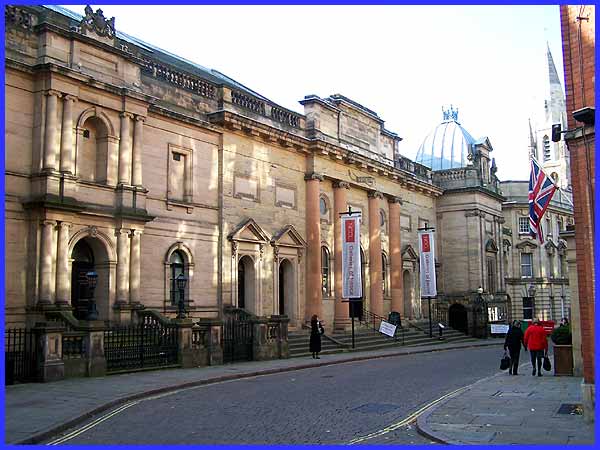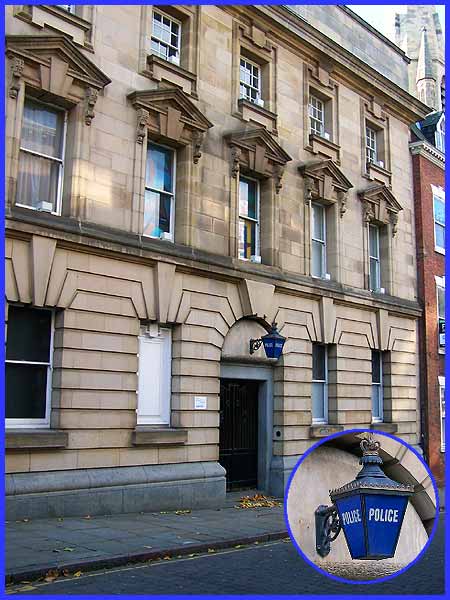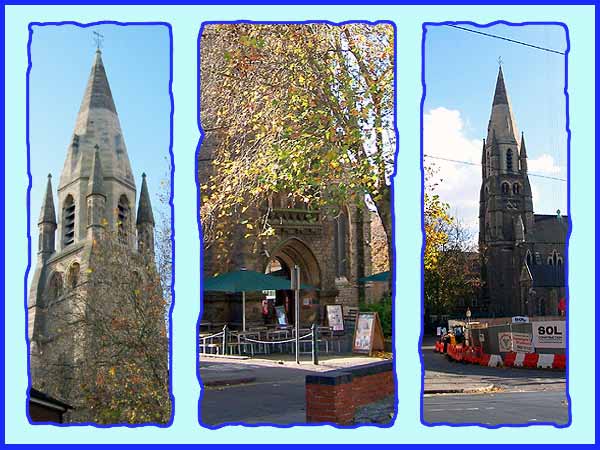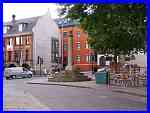Historic Nottingham - Part 7 - High Pavement
w/e 11 November 2007
All this week's pictures were taken
with a Kodak DX6490
I started the previous part in our walk through historic
Nottingham by saying that we would take a pause to see a little
more of St Mary's Church. That pause, due to some unforeseen
circumstances not least my sprained ankle which severely curtailed
my walking for quite a while, lasted much longer than I envisaged
at the time but we can resume now on the steps of the Church
as we continue into High Pavement.

There are three "Pavements" in Nottingham, High, Middle
and Low, all of which we'll cover as we make our way  back to Nottingham Castle. When most streets
in Nottingham were simply mud tracks the Pavements were the three
mediaeval streets that were cobbled. It was between the seventeenth
and nineteenth centuries that some of the great Nottingham families
took up residency in High Pavement in what became the "select"
part of town. We join High Pavement about half way along its
length and the imposing building that immediately draws the eye
is Shire Hall. This is now a museum and tourist attraction and
as the "Galleries
of Justice" takes visitors on a journey through 300
years of Crime and Punishment on the site. The facade of building
by James Gandon dates from 1770-2 but the building was extended
and remodelled by T. C. Hine between 1876 and 1879. back to Nottingham Castle. When most streets
in Nottingham were simply mud tracks the Pavements were the three
mediaeval streets that were cobbled. It was between the seventeenth
and nineteenth centuries that some of the great Nottingham families
took up residency in High Pavement in what became the "select"
part of town. We join High Pavement about half way along its
length and the imposing building that immediately draws the eye
is Shire Hall. This is now a museum and tourist attraction and
as the "Galleries
of Justice" takes visitors on a journey through 300
years of Crime and Punishment on the site. The facade of building
by James Gandon dates from 1770-2 but the building was extended
and remodelled by T. C. Hine between 1876 and 1879.
|

There is a very interesting and comprehensive article about the
Shire Hall on the Nottinghamshire History website (link) but suffice it to say here that the
site was in use as courts and prisons from the 1780s to the mid
1980s although there has been a court here since at least 1375
and a prison since 1449. The Shire Hall is now a Grade II listed
building but two features at the front of the building could
so easily be missed with just a casual glance. First if you look
carefully at the words "County Gaol" over the basement
door, you will notice that the original stonemason transposed
two of the letters which were later corrected. Hopefully he achieved
his goal and escaped with his life, thus avoiding the gallows
that stood in front of the building. The holes where the gallows
stood are now concrete filled but their positions can still be
seen on the steps.
|

Standing next to the Shire Hall is another Grade II listed building,
that of the former police station of 1905. This Edwardian building
still has the blue lamp over the door and leaves you in no doubt
as to the building's use. A blue lamp traditionally hung outside
police stations and in 1950, Ealing Studios actually released
a crime film titled "The Blue Lamp". The star of the
film was Jack Warner and as George Dixon, he dies at the end
of the film. This didn't stop him being resurrected though for
a television series "Dixon Of Dock Green" that ran
for twenty one years between 1955 and 1976 with Warner still
in the title role. Although the film has nothing to do with Nottingham,
the sight of the blue lamp on High Pavement would evoke similar
memories with those old enough to remember George Dixon. But
in real life it seems that summary justice could be seen to be
meted out on High Pavement - from police station to court, gaol
or the gallows in quick succession.
|

This part of Nottingham is more than well endowed with listed
buildings and the former Unitarian Church built in 1876 is yet
another to add to the list on High Pavement. At the time of publication
of Malcolm Sales' "100 Walks In Nottinghamshire" ten
years ago, the building was being used as a lace industry museum
and exhibition centre and was known as the Lace Hall. The west
tower and octagonal spire still stands high above the street
but the intervening period has seen the church transformed into
"The Pitcher and Piano" bar serving food and drinks.
Malcolm Sales' book at this point becomes a little sketchy referring
to information boards giving the history of the area. Boards
near the former church though have been removed - hopefully only
on a temporary basis - whilst construction work is carried out
in the adjacent site.
|

When the lace museum closed it transferred across the road into
an eighteenth century town house (yes, it's listed too) but its
stay here was short-lived and the building is currently the High
Pavement Business Centre. Nottingham still has its lace museum
though and we passed it in Part 1 of this series near the Castle.
|

High Pavement meets Low Pavement at Weekday Cross which was once
the site of the mediaeval Town Hall and weekday market dating
back to Saxon times. The stone cross that stood in the open market
place gave the place its name which has survived to the present
day. Over time, market trading and new civic buildings grew up
a little further away around the Great Market Place (now known
as the Old Market Square) and the importance of  Weekday Cross gradually declined. Eventually
the old Town Hall was demolished in 1894 to make way for the
Great Central Railway. Weekday Cross gradually declined. Eventually
the old Town Hall was demolished in 1894 to make way for the
Great Central Railway.
After the Norman Conquest, Nottingham Castle was built on the
hill to the west and the valley between was settled by Frenchmen.
Trade between residents of the English and French boroughs took
place at a Saturday market in the Great Market Place which eventually
became the town centre but in the next part we will continue
to that French quarter along Middle Pavement and into Low Pavement.
|

